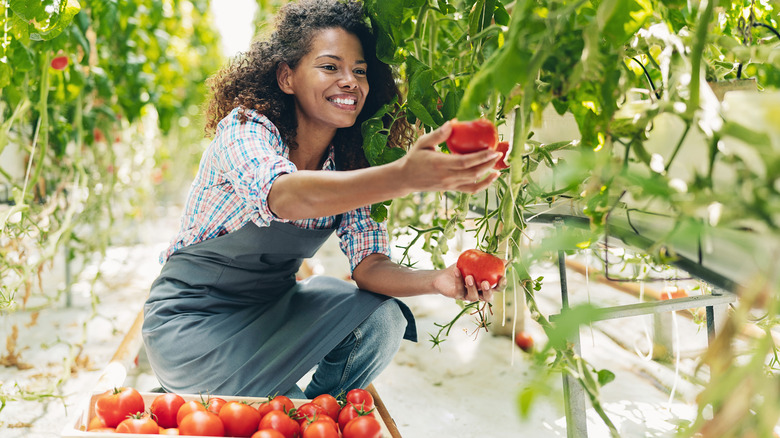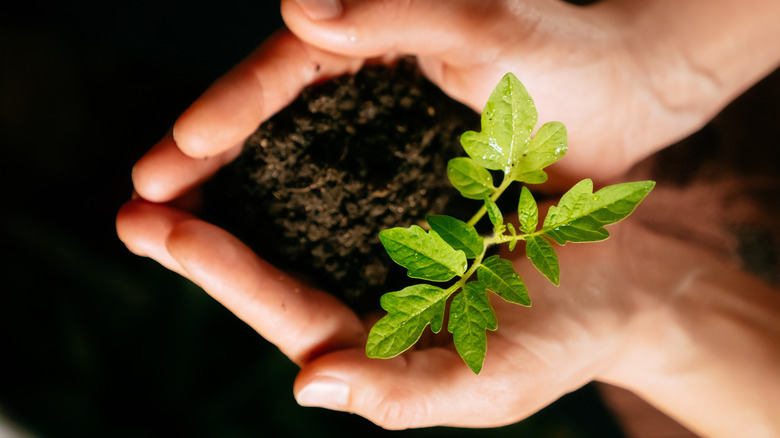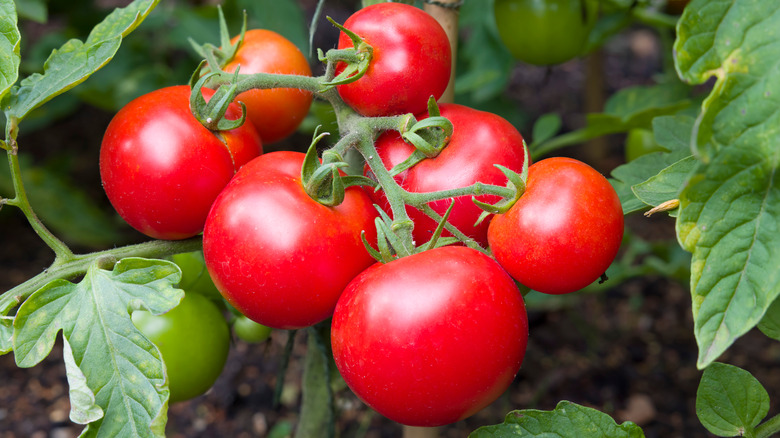How To Grow Juicy Tomatoes From Seed To Bring Some Flavor To Your Garden
In spite of the fact that tomato plants are found in 86% of American food gardens, according to The National Gardening Association – one gets the feeling that growing them is more art than agriculture. The whole business of keeping them healthy and flavorful seems to swirl in mysterious advice of myth, ritual, and even the occasional superstition. But getting most of the way to the perfect tomato is actually fairly simple, and it's more method than magic. The method starts before you plant a single seed: choose the right variety, start it right, pay attention to light and water, and treat them properly after you pick them.
First, you'll want to decide between determinate or indeterminate tomatoes, or choose both. Determinate tomatoes (or bush tomatoes) are limited in height. Typically, they'll only reach about 4 inches tall and their fruiting season is shorter, albeit heavier. Popular varieties are Roma tomatoes and San Marzano tomatoes. In contrast, indeterminate tomatoes, also known as vine tomatoes, will grow taller and keep fruiting until the first frost. Some of the most well-known indeterminate tomatoes include Sungold, Cherokee purple, Brandywine, and others among the delicious heirloom tomato varieties. Despite which type of tomato you prefer, you'll need to know how to grow them from seed to get the most flavorful harvest possible.
Starting tomato from seeds
The reasons for growing tomatoes from seed rather than buying plants are because it's much cheaper, you can start earlier, and it's more efficient. You'll be able to harvest indoor-started tomatoes a few weeks earlier, but it is a lot more work. You have to have healthy plants to have delicious tomatoes, and that starts with seeds. They can be directly sown outside when your soil temperature maintains at least 50 degrees Fahrenheit including at night. Placing a toothpick near direct-sown tomato seedlings will help discourage cutworms. However, it may be better to start them indoors to have more control over their growing conditions. When growing tomatoes from seed indoors, do so about six weeks before your area's average last frost. Use sterile seed-starting mix and a heat mat to get the soil temperature up to 70 to 75 degrees Fahrenheit, and discontinue the mat after germination.
Use adjustable grow lights that will allow you to position lights 1 to 2 inches above your seedlings, starting when the first true leaves (as opposed to seed leaves) appear. Distant or low light will produce leggy seedlings, which you may wish to avoid. Use fan to circulate air around your plants to help prevent diseases — the air movement may strengthen tomato stems. If you used that sterile and nutrition-free seed-starting mix, your seedlings will need diluted liquid fertilizer starting around when their second set of true leaves appear. Harden off your tomato plants before transplanting them outside.
Growing beyond the seedlings
When it's time to transplant your tomatoes outdoors, pay attention to your plants. Leggy seedlings can be buried as deeply as possible, and roots will sprout all along the buried stem. Once they take root and start to grow, your journey as a seed-starter is over and you're just tending tomato plants like everyone else. Managing nutrients and water is a big part of growing yummy tomatoes, but stay calm. You don't need to add Epsom salts unless you have a soil test showing your soil has a magnesium deficiency, and if your plants have a calcium deficiency it's more likely to be caused by uneven watering than by lack of calcium in the soil, but you can test your soil to be sure.
Focus on regularly watering your tomatoes, but don't drown them. You can rescue an overwatered tomato plant, but it's not ideal. Prune your tomato plants toward the bottom to encourage a larger yield and prevent diseases by encouraging bigger growth up top. It will take around 60 to 100 days for your tomatoes to go from seed to harvest, depending on which variety you've grown. Don't be shy about harvesting early while tomatoes are still green but starting to turn color; that old myth about ripening tomatoes on the vine isn't quite right, according to our master gardener. It could be better for tomatoes to ripen off the vine and in your home.


